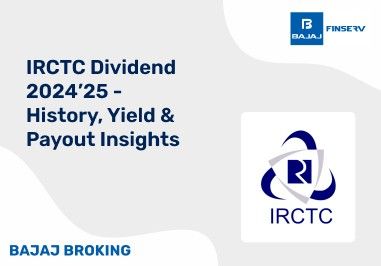BAJAJ BROKING
Tankup Engineers IPO is Open!
Open a Free Demat Account
Trade Now, Pay Later with up to 4x
Track Market Movers Instantly
ROC: Rate of Change Indicator - What is it, How it works, Calculation
Introduction
In the era of online trading, traders mustn't rely solely on themselves to do all the analytical work. Digital trading has enabled us to get access to trading records and other relevant market data with great ease. Several analytical techniques can be used on these datasets to help us get insights. One such tool is the ROC indicator. Let’s discuss what ROC is and how it is used.
What is the Rate of Change (ROC) Indicator?
The stock market is a dynamic space, and the prices of shares constantly keep changing. At any given point in time, a trader would want to know the rate at which the price is changing. This can be understood by a metric called the Rate of Change Indicator. It compares the price change in a recent period with a previous period and arrives at a rate. This is often used to determine the strength and direction of price movements in the market.
How It Works
The ROC Indicator is a momentum oscillator and it oscillates above and below a zero line. It reflects the rate of price change. Prices are rising when the ROC is above zero, or positive, and the prices are falling when the ROC is below zero, or negative. When the ROC is more distant from the zero line, the rising/falling momentum is understood to be stronger.
Calculation
The ROC can be calculated for any period, but the most commonly used durations are 12 and 25 days. While you can calculate ROC for any timeframe, the 12 and 25-day periods are the most popular choices.
ROC can be calculated by dividing the difference between the current price of the stock and the base price of the stock by the base price of the stock. Here, the base price would be the price of the stock on base day, which could be 12 days back or 25 days back. As with any rate, this result is then multiplied by 100 to get a percentage value.
Here’s a detailed step-by-step guide to calculating ROC.
- Select the base period: If you choose the period as 12, 14, or 25 days back, then the base price will be determined accordingly. Any number of days can be chosen, but the common numbers are these three.
- Find the current price: Note down the closing price of the stock for the current period.
- Find the base price: Note down the closing price of the stock for the base period.
- Apply the Formula: Subtract the base price from the current price, divide the result by the base price, and multiply by 100 to get the percentage value.
To understand how this works, let’s take an example.
Base period - 12 days
Current price - 120 INR
Base price - 100 INR
ROC would be 20 (120-100=20) divided by 100, which would be 0.2 or 20 percent.
If you would interchange the current and base prices the trend would reverse and you would arrive at an ROC of minus 0.2 or minus 20 percent.
Additional Read: Fractal Indicator
Interpreting the ROC Indicator
- Above Zero: If ROC is positive, or above zero then the momentum is upward and the higher the number is the stronger the momentum.
- Below Zero: If ROC is negative or below zero then the momentum is downward, and again the momentum is higher when the number is higher.
- Overbought/Oversold Conditions: When ROC value is a large number then it is an indication that the shares are being overbought. Similarly, when the number is very low then the shares are probably being oversold. High and low are relative terms here, and are to be understood based on the numbers found in the dataset.
How is ROC useful?
ROC is instrumental in trading technical analysis and is one of the important swing trading indicators.
- Identifying trends: ROC can help us identify how strong a trend is and in which direction it is moving. The momentum can be understood from the value of ROC.
- Buy/sell signals: When ROC values continue to increase and cross the zero line, it is often considered a signal to buy. And similarly when they continue to decrease it is a signal to sell. The zero line is where the difference between the current and base prices is zero.
- Spotting divergences: Divergences happen when price and ROC move in opposite directions. When the price falls but ROC values go on rising, it is considered a bullish divergence and it indicates the possibility of an upward reversal. The converse is considered a bearish divergence.
- Overbought/Oversold: ROC can also help us identify the overbuying and overselling of shares. The momentum and trend can easily indicate these conditions.
Conclusion
The ROC indicator can be a powerful tool. It helps us measure the percentage change in price over a period, which in turn aids in identifying momentum, generating buy/sell signals, spotting divergences, and noticing overselling/overbuying trends.
Disclaimer: Investments in the securities market are subject to market risk, read all related documents carefully before investing.
This content is for educational purposes only. Securities quoted are exemplary and not recommendatory.
For All Disclaimers Click Here: https://bit.ly/3Tcsfuc
Share this article:
Read More Blogs
Disclaimer :
The information on this website is provided on "AS IS" basis. Bajaj Broking (BFSL) does not warrant the accuracy of the information given herein, either expressly or impliedly, for any particular purpose and expressly disclaims any warranties of merchantability or suitability for any particular purpose. While BFSL strives to ensure accuracy, it does not guarantee the completeness, reliability, or timeliness of the information. Users are advised to independently verify details and stay updated with any changes.
The information provided on this website is for general informational purposes only and is subject to change without prior notice. BFSL shall not be responsible for any consequences arising from reliance on the information provided herein and shall not be held responsible for all or any actions that may subsequently result in any loss, damage and or liability. Interest rates, fees, and charges etc., are revised from time to time, for the latest details please refer to our Pricing page.
Neither the information, nor any opinion contained in this website constitutes a solicitation or offer by BFSL or its affiliates to buy or sell any securities, futures, options or other financial instruments or provide any investment advice or service.
BFSL is acting as distributor for non-broking products/ services such as IPO, Mutual Fund, Insurance, PMS, and NPS. These are not Exchange Traded Products. For more details on risk factors, terms and conditions please read the sales brochure carefully before investing.
Investments in the securities market are subject to market risk, read all related documents carefully before investing. This content is for educational purposes only. Securities quoted are exemplary and not recommendatory.
For more disclaimer, check here : https://www.bajajbroking.in/disclaimer
Our Secure Trading Platforms
Level up your stock market experience: Download the Bajaj Broking App for effortless investing and trading













